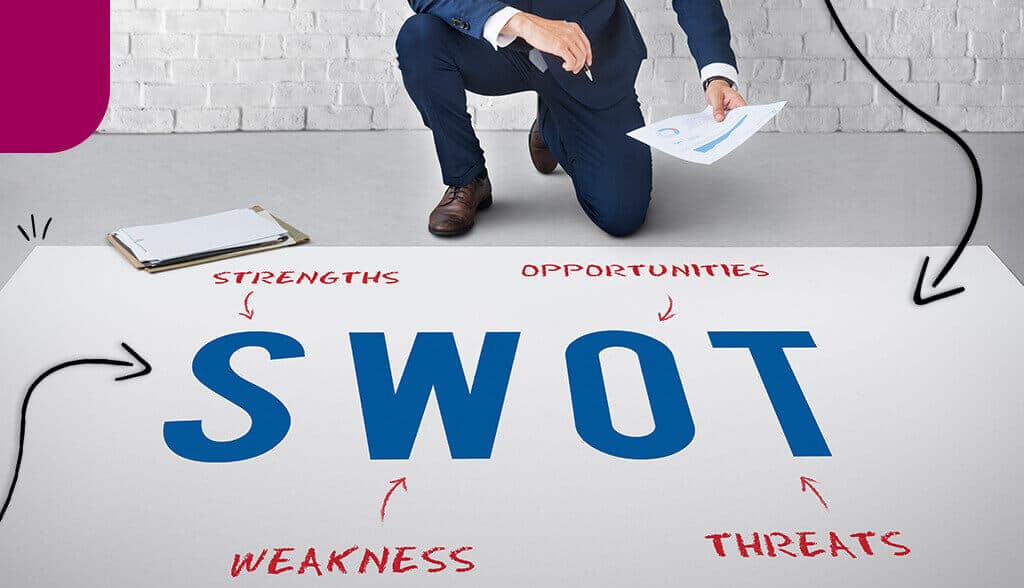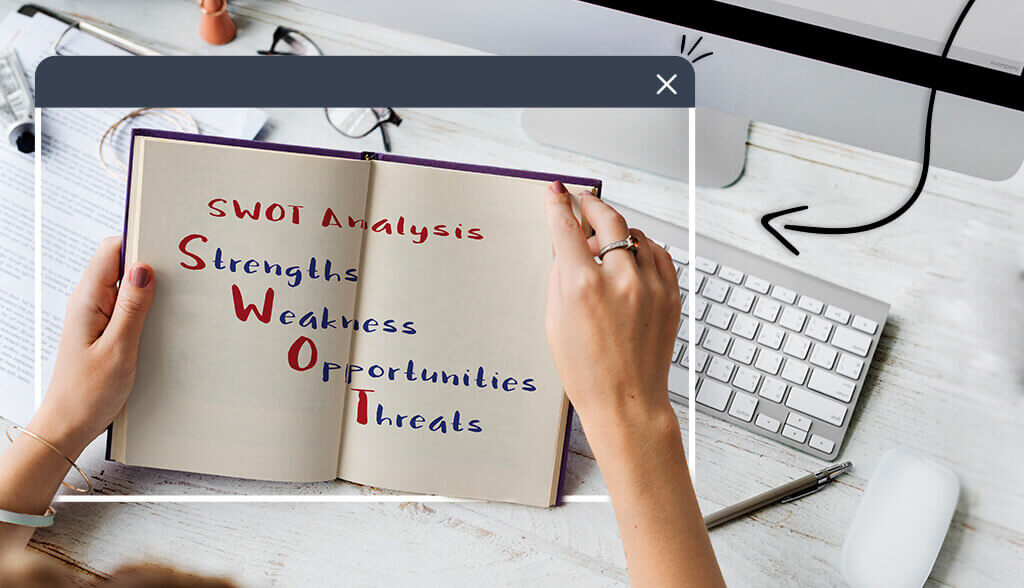
Albert Humphrey of Stanford Research Institute invented the SWOT analysis in the 1960s to help organizations improve their strategic planning and make better business decisions.
Since then, businesses have been using SWOT analysis to examine the external and internal factors that support or constrain their ability to succeed.
Insights into these factors enable you to read between the lines, cut through the clutter, and create a robust action plan.
Businesses use SWOT analysis to find genuine answers to crucial questions rather than relying on what-ifs and maybes.
SWOT is an acronym for strengths, weaknesses, opportunities, and threats used to analyze all 4 aspects of your business to determine your level of ability to operate in your marketplace.
SWOT analysis looks at both internal and external factors.
These factors happen within your business and are in your control, such as your human resources, operational efficiencies, products, brand name, marketing strategies, and location.
Your goal when analyzing your internal factors is to identify your strengths and weaknesses, such as:
External factors happen outside your business and are not in your control. Characterized by relevant environmental, economic, technological, and social trends. Including your competitors, your suppliers, global economics, product costs, and even the weather.
Your goal when analyzing your external factors is to identify your opportunities and threats and find answers to questions like:
At Tailor Brands, we intrinsically employ SWOT analysis when clients use our logo-making tool.
Our AI focuses on industry branding opportunities by asking relevant questions about your niche; it then selects colors, fonts, shapes, and styles that suit it.
We base our decisions on your internal strengths (your niche and brand personality) and external opportunities (your marketplace and target audience).
The results enable you to enhance your brand’s voice and personality to attract and connect with your target audience’s emotions.
It’s a simple but powerful example of how a SWOT analysis can provide instant beneficial results that continue giving back long after completion.

You conduct a SWOT analysis to identify areas where your business excels or flat lines, spot opportunities, and recognize threats.
When you identify these factors, you can take actions that secure your market share and ensure your brand remains relevant.
Let’s look at how you can use SWOT analysis to your advantage.
A communication SWOT analysis reviews your brand’s reputation with its target audience. It examines the marketing strategies you use to communicate and how effectively you execute them.
Its goal is to ensure your brand meets your target audience’s expectations by having the same identity and values.
SWOT analysis is also a diagnostic tool perfect for strategic planning. You can assess your internal/external capabilities and resources and use the results to make better business decisions based on facts, not fiction.
SWOT analysis communication and diagnostics tools enable you to identify opportunities and implement strategic plans to take full advantage.
A SWOT action plan generator ensures you complete your analysis, recognize any connections between all 4 factors, build tactics around those connections and create an active process.
Let’s look at how that process works next:

Your SWOT analysis results can help improve your strategic planning and decision-making processes and make good business decisions based on proven facts.
I’ll illustrate how it works by using my local plumber, Matt, as an example.
Your action-driven SWOT is a plan that outlines where, when, and how you’ll use all 4 elements of your SWOT analysis to the best effect. But first, you must determine your internal strengths and weaknesses.
Strengths and weaknesses are inner, which means you already have the resources that define them, such as your brand, popular products or services, location, staff, etc.
To identify your strengths, consider your niche, your customer’s needs, and the problems you solve. Now list all the strengths associated with your products or services and how they benefit your audience.
Matts’ niche is an energy-efficient water heater; his customers want to reduce their bills. His product solves that problem, and they benefit by saving money.
Your weaknesses are where your business model does not meet your customer’s needs and often become apparent when reviewing your strengths.
Use the following 3 questions to find your strengths and weaknesses:
What are your business core competencies?
Your core competencies are elements unique to your business that give you a competitive advantage, such as your products, services, equipment, or marketing strategies.
Your market positioning is how your target audience perceives your brand; you influence that perception using promotions, products, price, and place. You can ensure you’re in the correct position and if it’s sustainable by reviewing your main competitors.
How do the resource constraints affect your strengths and weaknesses?
Resource constraints are any internal limitations associated with your project that could derail your business, such as limited product production, lack of finances, or operational inefficiencies.
External threats are harmful factors you don’t control. For example, a competitor selling an identical heat pump water heater at a lower price would affect Matt’s plumbing business.
While you can’t control your competitors, you can prepare and plan by identifying opportunities and threats by answering the following questions:
Who are your customers and how do they view your business?
Regular contact with your customer base through social media and testimonials is how you know who they are and how they feel about your business.
How do your competitors fare?
Review your competitors on testimonial websites to see what their customers say about them. And look at their marketing strategies to gain insights into how well they’re performing. For example, are they using paid ads or do they rely on organic SEO?
How might external factors (the market) affect your business?
External threats are harmful factors you don’t control. For example, a competitor selling an identical heat pump water heater at a lower price would affect Matt’s plumbing business.
Consider how a price rise in raw materials or increasing competition might affect your sales points and whether you could remain competitive.
What could happen to your business because of these external factors?
Critical reviews, competition, and increasing material costs could negatively affect your business. What you need to know is if they could put you out of business. If so, those are threats you must prepare for.
A SWOT evaluation involves reviewing and cross-checking your SWOT analysis results to confirm their accuracy, usefulness, strengths and weaknesses.
At Tailor Brands, for instance, 2 of our strengths are our recognized branding and AI logo-making service; people know who we are and what we do.
With Matt’s heat pump business, a weakness could be his product’s high sales price. Still, his strength is the cheap running costs compared to standard gas and electric models.
How to evaluate your SWOT:
Does it form a data-intensive/backed narrative?
A data-intensive narrative is a written summary of your SWOT analysis that makes comparisons and draws conclusions to explain the data. In other words, it presents the data in an easy-to-understand way.
Are the points “action-driving”?
Your SWOT analysis results must be actionable so that you can implement them without too much effort or cost.
Does it ward off decision paralysis?
Your action-driven SWOT aims to clarify the steps you need to take. Don’t overload yourself with information as it could create confusion between internal and external environments.
Does it bring together the different areas of emphasis and leverage?
The 4 SWOT elements don’t operate in a vacuum; each influences the other somehow. Your SWOT must identify these connections so you can find solutions to any threats or weaknesses.
Does it lead to a robust plan of action?
A robust action plan also includes “what,” “who,” and “when.” These outline what steps you’ll take to achieve your goals, who’s responsible for implementing them, and when they must complete them.
Is it realistic for your business?
Any actions your SWOT analysis suggests must be realistic and deliverable within your existing internal resources; otherwise, you could overextend yourself.
Does it avoid the “what-if” factor?
A SWOT analysis with what-ifs is about as useful as a decaf espresso. When evaluating your analysis, ensure you leave no stone unturned, no matter how small.
Next, evaluate your SWOT analysis to identify areas you can develop, such as eliminating weaknesses or increasing strengths to provide further opportunities.
Doing so reduces the what-ifs and increases your ability to make good business decisions.
Ask these questions to develop your SWOT:
What could you add to the SWOT?
Review your SWOT analysis and look for strengths or weaknesses that could become opportunities or threats.
What should you leave out of the SWOT?
Long lists and listing too many things are common SWOT analysis mistakes caused by not having an obvious goal.
Do the priorities make sense?
As a small business, you must be careful where you invest your funds.
Evaluate every opportunity your SWOT analysis illuminates to ensure they’re worth the investment.
Are the critical success factors realistic?
Critical success factors are elements of your business that determine its success. For Matt’s heat pump business, critical factors would be product availability, purchase and resale price, and consumer demand.
Regardless of your business’s critical success factors, they must be obtainable; otherwise, you could chase a white rabbit!
While performing your SWOT analysis, look for factors that can help influence your business decisions, including internal strengths/weaknesses and external opportunities and threats.
Once identified, create a strategy based on the following questions and put them into action:
What do you need to start doing, stop doing, and continue doing?
Weaknesses identify what you should start and stop doing. For example, are your competitors using marketing platforms you’re not? Are you selling products that are no longer in high demand?
What do you need to do more of or less of?
No one wants to waste money and we all want a high return on investment.
Perhaps you’re buying paid advertising and not seeing results, but traditional marketing campaigns are proving worth it; if so, redirect your resources.
How are your resources favoring or constraining the success of your plan?
You need adequate resources to implement a plan. These can include funding, staff, new products, materials, or software for online services. Calculate the costs of your SWOT analysis suggestions to ensure you can afford them.
After the hard work is done, you now must monitor your new strategies. Monitoring helps maintain your focus, clarifies your ideas, and increases the chances of achieving your objectives.
Ask yourself the following questions when monitoring progress:
What have we learned?
Implement a review session to learn from your wins and losses because both can help you make better business decisions.
How have we grown as an organization?
Perhaps you’ll change from a sole proprietorship to an LLC or expand from a brick-and-mortar business to include e-commerce. Whatever you do, track your evolution to ensure you’re moving in the right direction.
What should we be doing differently to achieve the goals?
Goals are great, but strategies are better. Often we don’t meet our goals because we didn’t implement a strategy that helps us achieve them.
Focus 90% of your energy on your strategy and 10% on the goal itself.
Review regularly and change your strategy, not your goal, if you’re falling short.
Conclusion
SWOT analysis is a crucial tool for planning and decision-making. It’s beneficial for any business seeking to transform its performance and realize its competitive advantage.
Give your business the time it deserves and use SWOT to identify your strengths, weaknesses, opportunities, and threats. Because when you do, you’ll be able to make business decisions you can rely on.
This portion of our website is for informational or educational purposes only. Tailor Brands is not a law firm, and the information on this website does not constitute legal advice. All statements, opinions, recommendations, and conclusions are solely the expression of the author and provided on an as-is basis. Accordingly, Tailor Brands is not responsible for the information and/or its accuracy or completeness. It also does not indicate any affiliation between Tailor Brands and any other brands, services or logos on this page.
Products
Resources
©2025 Copyright Tailor Brands